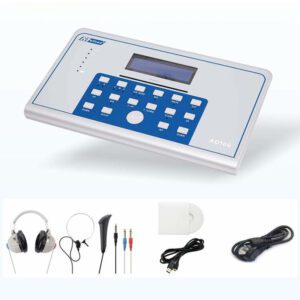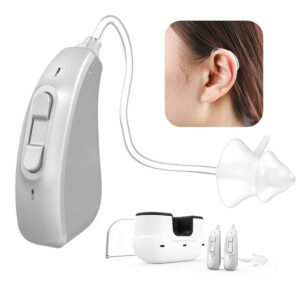Headphones have become part of our everyday life—whether we’re working, gaming, commuting, studying, or relaxing with music. But with more people wearing headphones for longer hours than ever, concerns about hearing damage are increasing.

So, can using headphones actually cause hearing Loss?
The short answer is yes—but it depends on volume, duration, and the type of headphones you use.
This guide explains how headphone use affects your ears, early symptoms of damage, and how to protect your hearing without giving up your favorite audio experience.
Do Headphones Cause Hearing Loss at Low Volume?
Many people assume that as long as the volume is “not loud,” headphones are safe. But low volume doesn’t always mean low risk.
Even at moderate volume levels, long exposure can harm your hearing over time. For example, listening at 60% volume for 6–8 hours daily may still strain your ears—especially if you’re in a noisy environment where you subconsciously turn the volume up.
Key point:
It’s not only about how loud your headphones are, but how long you use them.
The World Health Organization (WHO) recommends:
Keep volume below 85 dB
Limit high-volume listening to less than 1 hour per day
If you listen for long hours daily, even “safe” volume levels can accumulate into long-term hearing stress.
How Headphones Damage Your Hearing
Headphone-related hearing loss is typically a form of Noise-Induced Hearing Loss (NIHL).
Here’s how it happens:
Sound waves enter the ear and stimulate tiny hair cells in the inner ear (cochlea).
Loud or prolonged audio overstimulates these cells.
Over time, the hair cells become damaged or die.
Once damaged, they do not regenerate, leading to permanent hearing loss.
Two types of hearing changes may occur:
Temporary threshold shift: short-term muffled hearing or ringing after exposure.
Permanent hearing loss: irreversible damage from repeated long-term exposure.
Ear Damage from Headphones: Early Symptoms to Watch For
Your ears often send warning signs long before the damage becomes permanent. If you notice any of the following, your ears may be stressed:
Ringing or buzzing in the ears (tinnitus)
Muffled or distorted hearing after using headphones
Needing higher volume than before
Ear pressure or discomfort
Difficulty hearing conversations in noisy places
Sound sensitivity or “ear fatigue”
If symptoms persist for more than 24–48 hours, it may be an early indication of long-term hearing damage.
Earbuds vs. Headphones: Which Is Worse for Your Hearing?
Not all listening devices affect your ears the same way, and some types pose a higher risk than others.
Earbuds (in-ear designs) are generally the most harmful because they sit deep inside the ear canal, placing sound closer to the eardrum. They also allow more external noise to enter, so users often raise the volume to compensate.
On-ear headphones rest on the outer ear and present a moderate level of risk. The sound is direct, but the design provides slightly better sound distribution than earbuds.
Over-ear headphones are often considered a safer choice. They fully cover the ear, offer better sound isolation, and allow people to enjoy clear audio at lower volumes.
Noise-cancelling headphones can be one of the safest options because they reduce background noise, making it easier to listen at a lower volume while still hearing clearly.
A useful rule to remember: the closer the speakers are to your eardrum, the higher the risk of hearing damage.
How Loud Is Too Loud? (dB Levels & Safe Listening Time)
To understand safe listening, it helps to compare everyday sound levels. Normal conversation is around 60 dB, and at this level, your ears are in no danger. City traffic noise is roughly 85 dB, and exposure should be limited to about eight hours to avoid harm.
Headphones at maximum volume can reach 100–110 dB, a level at which hearing damage may begin after only a few minutes. By comparison, concert speakers often reach 120 dB, where even a single minute of exposure can be harmful.
A simple guideline: If your ears ring or your hearing feels muffled after listening, the volume was too loud.
How to Reverse Hearing Loss from Headphones
Whether hearing loss can be reversed depends on the extent of the damage.
Temporary effects that may recover include:
Brief tinnitus
Temporary muffled hearing
Ear fatigue
These symptoms often improve after 24–48 hours of reduced sound exposure.
Long-term or repeated exposure, however, can cause permanent damage to the hair cells in the inner ear. Once this happens, hearing cannot be naturally restored.
Helpful recovery steps:
Give your ears a break—avoid loud environments for a day or two
Lower your daily listening time and volume
Practice sound therapy or relaxation sound exercises for tinnitus relief
Seek evaluation from a hearing specialist if symptoms do not improve
Acting early is essential—ignoring the warning signs increases the likelihood of permanent damage.
Safe Listening Habits to Protect Your Hearing
Protecting your hearing doesn’t mean giving up headphones. You can still enjoy your music, movies, and calls while staying safe by building healthy habits:
Follow the 60/60 rule: maximum 60% volume for no more than 60 minutes at a time
Take 5–10 minute listening breaks every hour
Choose noise-cancelling or over-ear headphones when possible
Keep volume low enough to hear someone talking near you
Avoid falling asleep with headphones or earbuds
For children and teens, keep volume lower than 50%
Final Thoughts
Headphones themselves aren’t the enemy—volume, duration, and listening habits are what determine whether your ears stay healthy. By keeping your volume at a safe level, limiting prolonged use, and choosing well-designed headphones that reduce outside noise, you can enjoy music without putting your hearing at risk.
If you are already experiencing symptoms such as tinnitus, muffled hearing, or difficulty understanding speech, it’s important to seek a hearing test early. Early detection can prevent further damage, and in cases where hearing loss has occurred, hearing Aids can help restore clarity and improve daily communication.
Protecting your hearing today means preserving your quality of life for years to come. Listen smart, stay aware of warning signs, and don’t hesitate to explore professional hearing support if needed.


